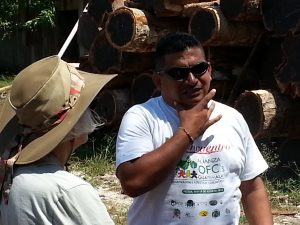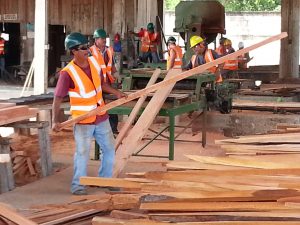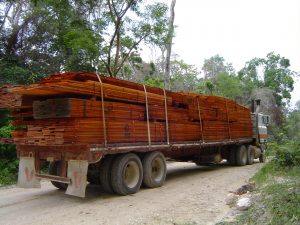Continuing a series of interviews on inclusive landscape finance, three members of the Association of Forest Communities of the Peten (ACOFOP) share their insights with Bas Louman of Tropenbos International.
Founded in 1997 to strengthen the position and user rights of communities in the Peten Mayan Biosphere Reserve, Guatemala, ACOFOP comprises 24 associated community organizations. Nine of these manage their forests under concessionary contracts covering more than 400,000 hectares.
In 2003, members created a commercial community enterprise (FORESCOM) to provide drying and molding services, technical advice on commercialization and financial services. They now generate USD 5 million annually, some of which is invested in social benefits such as local health and education services.
Some funds are used for reinvestments in protection and control of the forests and prevention and control of forest fires. National Geographic and the New York Times have reported their successes in integrated and sustainable forest management.
ACOFOP member, Teresita Chinchilla; administrative advisor for member organizations, Elmer Mendez; and Mario Rivas of the productive and commercial area of FORESCOM share their views.
How do you define ‘inclusiveness’ and why should it be addressed by financial institutions?

We have not really thought about the topic as such. ACOFOP and FORESCOM work with private banks and receive income from product sales. As access to loans is not easy, we also rely, in part, on international cooperation, for example for technical assistance. For example, the purchase of equipment for use by members was partially financed by international cooperation and after several years these were bought by the organizations.
In addition, it is a challenge to make efficient use of the harvesting season. Despite organizations always paying back loans, the topic of forestry has still not been able to generate enough trust with banks regarding the administrative procedures needed for applying for operational loans, given that they continue to ask for collateral while the organizations work on state land. As such, some of the organizations set aside their own funds for harvesting, or make arrangements with buyers, making payments in the form of timber.
Read also: Scaling up sustainable forestry projects key to attracting finance
What are the structural barriers to financing smallholders and small- and medium-sized enterprises (SMEs)?
First of all, it is difficult to build the trust required to allow loan applications to be processed more rapidly. Another barrier is the need to provide guarantees, especially when most communities do not own the land or property where they harvest the trees and only have concessions over the use of state forests.
Also, loans are usually for one year, and the timing of disbursements and demands for repayments are not adapted to natural harvesting cycles. In general, financial products need to be adjusted to better meet the needs of community forest enterprises, and loan negotiations are made more difficult because credit agents are not aware of the specific needs of forestry businesses.

Finally, the costs of borrowing are high at 16-24 percent per year, although ACOFOP has been able to negotiate 12 percent in some cases.
Other barriers are related to smallholders’ own experience in running commercial operations. This sometimes creates problems in product delivery and cash flow. Non-timber forest products also face the same barriers, such as with the leaves of the xate palm (Chamaedorea sp.).
Most are sold to US customers with payment upon delivery, causing problems for harvesters especially when payments are delayed. As such, harvesters now demand advance payments from the organization. Others shift towards more opportunistic buyers, selling xate leaves at lower prices but receiving payment more quickly.
How is your organization addressing the financing needs of smallholders and SMEs, and what have you learnt from that?
Members of ACOFOP worked together to solve several structural barriers. In 2004, for example, we founded FORESCOM as a commercial company, contracting qualified personnel for the provision of technical support in forest management, business administration and marketing. Together, we have received international funding which allowed us to invest directly in community enterprises.
More recently, FORESCOM, with the support of ACOFOP, community enterprises and the Agricultural Research and Higher Education Center (CATIE), established a new finance mechanism to provide loans to member organizations at lower interest rates (9 percent) and with greater flexibility regarding the documentation required.
Usefully, loans have a payback period of three years, instead of the usual one year for commercial bank loans. The fund is still small, but we seek to increase it during the coming years. ACOFOP and FORESCOM have also assisted their members in seeking partnerships for financing.
Read also: More dialogue needed between farmers, forest enterprises and finance providers
What examples do you have of successful or promising financial innovations that promote environmentally sound and socially inclusive investments?
We consider ourselves a good example of progress towards sustainable use of natural resources within our landscape, leading to socio-economic benefits for the local population. From our experience, we have learnt that this requires an integrated approach, within which financial innovations are a key component. And these financial innovations have come more from within our local organizations as there has been limited access to private banks and other financial institutions for our members.
We felt the need to create our own fund that allows our members to obtain loans more appropriate to their needs, at lower interest rates, with more flexible repayment periods, and more flexible documentation and guarantee requirements. For example, community management plans and their annual harvesting authorizations form the basis of the loan applications.

A second internal innovation is increasing financial literacy. Community enterprises were supported to formalize themselves as not-for-profit organizations or as for-profit organizations, the main difference between these two being the distribution of benefits.
With both, they decided that 30 percent of net income should be reinvested in forest operations. As a not-for-profit enterprise, the rest is invested in social or productive projects that benefit communities. In the for-profit enterprises, most net income is invested in other projects not necessarily within the community, or is distributed among the community owners of the enterprise.
A third innovation that we are working on is the creation of a fund that can provide advance payments to organizations that trade in palm leaves. The idea is that this fund will grow from a charge on buyers and will be managed by a trust fund and the commercial operations of FORESCOM.
It was felt necessary to create such a fund because payments for palm leaves shipped to buyers are often delayed for months, putting the palm leaf collectors under economic stress. Access to this fund would allow collectors to continue their normal activities, while repayment to FORESCOM is guaranteed once buyers have confirmed the quantity of products received.
Finally, ACOFOP considers it important that community organizations participate in the formation of national financial mechanisms that aim to capture climate finance, to ensure it reaches the communities directly, or through intermediary organizations.
Part of the current problem is that much of this fund stays at the institutional level rather than being used for actions on the ground that benefit local people. ACOFOP is working on this at the moment, but so far it has only had limited responses from governmental institutions. We consider that national mechanisms need to be more open to inputs from community-based organizations.
Read more about ACOFOP operations here.
By Bas Louman, Tropenbos International.
This interview has also been published on the Tropenbos International website.
This article was produced by Tropenbos International (TBI) and the Center for International Forestry Research (CIFOR) as part of the CGIAR Research Program on Forests, Trees and Agroforestry (FTA). FTA is the world’s largest research for development program to enhance the role of forests, trees and agroforestry in sustainable development and food security and to address climate change. CIFOR leads FTA in partnership with Bioversity International, CATIE, CIRAD, INBAR, ICRAF and TBI. FTA’s work is supported by the CGIAR Trust Fund.











